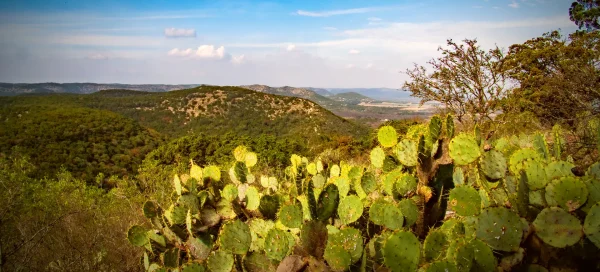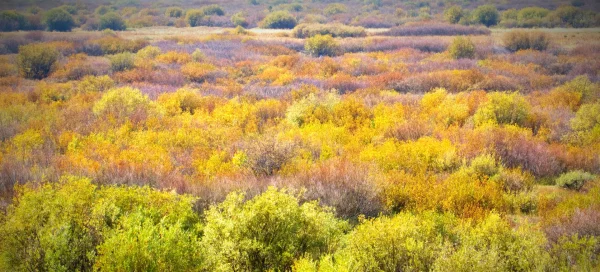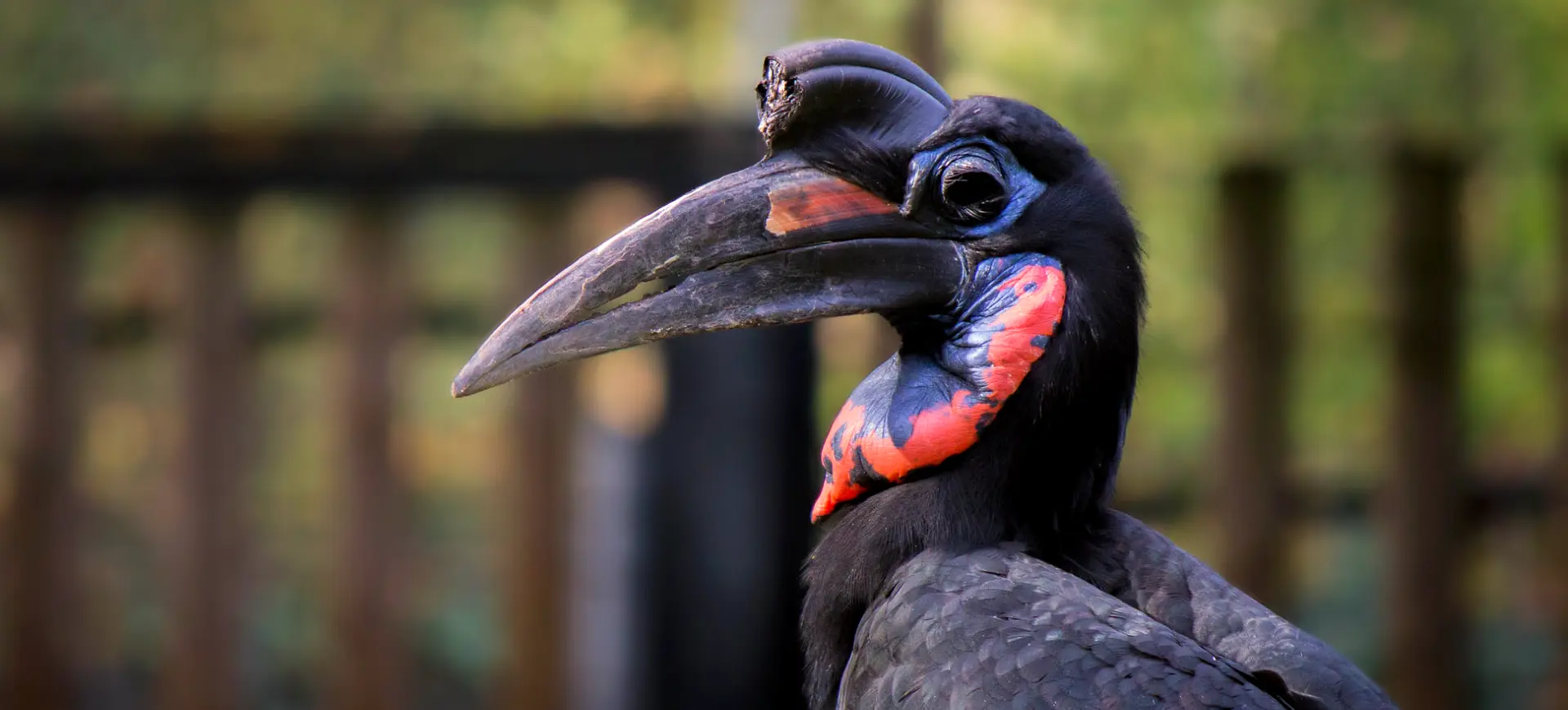Overview
The Southern Ground Hornbill (Bucorvus leadbeateri) is a striking, charismatic bird with a distinctive appearance and unique behavior. The largest species of hornbill is recognizable by its jet-black plumage, contrasting vivid red facial and throat skin, and large, heavy bill topped with a casque, a distinctive hollow structure of the species. The bird is about 90 to 129 cm tall, making it a standout species in its native habitats.
Southern Ground Hornbills inhabit various environments and prefer savannas, grasslands, and open woodland areas. They are predominantly terrestrial, using their strong legs to forage across large home ranges. Their diet is omnivorous, and they can consume various food items, from insects and rodents to snakes, frogs, and occasionally carrion.
The bird is known for its unique social structure and reproduction system, often living in cooperative groups where the dominant pair is aided in breeding and raising chicks by the rest of the group members. These fascinating attributes, coupled with their role as a top predator in some ecosystems, make Southern Ground Hornbills a critical component of the environments they inhabit.
Taxonomy
Kingdom
Phylum
Class
Order
Family
Genus
Species
Type
Physical Description:
The Southern Ground-hornbill is a large, robust bird with long legs and a strong bill. The species possesses an elongated neck and a casque – a hollow structure – on the bill. The casque starts as a small bump in juveniles, developing into a large structure by adulthood. The bill is down-curved and hooks at the tip. Adult males are larger than females, with a more developed casque.
Their size makes them imposing, with males reaching up to 4 feet in length from head to tail and a wingspan exceeding 6 feet. The size and shape of their bodies, along with their powerful beaks, make them formidable predators. Despite their large size, they can’t spend the most time on the ground foraging for food.

Lifespan: Wild: ~60 Years || Captivity: ~60 Years

Weight: Male: 13 lbs (6 kg) || Female: 9 lbs (4 kg)

Length: Male: 43 inches (109 cm) || Female: 39 inches (99 cm)

Height: Male: 39 inches (100 cm) || Female: 37 inches (93 cm)

Wingspan: Male & Female: 70 inches (180 cm)

Top Speed: 20 mph (32 km/h)
Characteristic:
Native Habitat:
Southern Ground-hornbills occupy various habitats but are most commonly found in savannas and grasslands. They prefer open terrain with sparse tree cover. They can also be found in woodland and scrubland areas. They generally avoid dense forests and deserts. They depend on trees for roosting and nesting and, thus, are not found in areas without trees.
They are ground-dwelling birds but nest in the cavities of large trees or on cliffs. They show high site fidelity, often returning to the same nesting site year after year. They require a large home range, often covering several square kilometers, foraging. However, they are territorial and will defend their home range from other hornbill groups.
Biomes:
Biogeographical Realms:
Continents:
Diet:
Diet & Feeding Habits:
Southern Ground-hornbills are omnivores, but their diet primarily consists of animals. They have been recorded consuming various prey, including insects, amphibians, reptiles, and small mammals. The powerful beak of the Southern Ground-hornbill allows it to deal with a variety of prey, including those with hard exoskeletons or shells.
They forage on the ground, usually in the early morning and late afternoon. When hunting, they walk in a line, searching for food in the grass and under debris. Prey is usually located by sight, but the hornbills will also use their beaks to probe into holes or under objects. They have even used their large bills to move rocks or debris when searching for food.
Mating Behavior:
Mating Description:
Southern Ground-hornbills have a slow reproduction rate, typically producing one chick every nine years. Their mating system is cooperative, where a dominant pair breeds and is assisted by subordinate helpers. Mating usually occurs during the dry season when resources are scarce. The mating ritual involves the male displaying bowing, puffing out his wattles, and short flights.
The female lays one to two eggs in a cavity in a tree or cliff and incubates them for around 40 days. Usually, only the first chick to hatch survives, as it will out-compete its sibling for food. The surviving chick stays with its parents for several years before leaving to establish territory or join another group.
Reproduction Season:
Birth Type:
Pregnancy Duration:
Female Name:
Male Name:
Baby Name:
Social Structure Description:
Southern Ground-hornbills form cohesive and structured social groups with up to nine members, primarily consisting of a dominant breeding pair and several subordinate helpers. These helpers, often the breeding pair’s previous offspring, play critical roles within the group by assisting in the care and rearing of the young. They also contribute significantly to defending the territory against intrusions from other hornbill groups, showcasing a highly organized and cooperative social system.
This species exhibits a strong territorial instinct, defending their established home ranges from competing hornbill groups. Their complex social structure facilitates the efficient use of habitat and resources and enhances the survival prospects of the group’s offspring. Through cooperative breeding and territorial defense, Southern Ground-hornbills demonstrate a sophisticated approach to living in their challenging environments, ensuring their social groups’ continued success and stability.
Groups:
Conservation Status:
Population Trend:
The Southern Ground-hornbill is classified as Vulnerable on the IUCN Red List due to its declining population trend. They have a low reproduction rate and are affected by habitat loss, hunting, and persecution. The estimated population in the wild is between 5000 and 8000 individuals.
Their long lifespan and slow reproduction rate make it difficult for populations to recover from declines. Populations are often patchy and isolated due to their specific habitat requirements and large home ranges. This makes them vulnerable to local extinction events.
Population Threats:
The Southern Ground-hornbill faces numerous threats, including habitat loss due to agriculture, logging, and human settlement. They are also vulnerable to poisoning and electrocution from power lines. The use of pesticides can reduce their prey availability. In some regions, they are hunted for use in traditional medicine or persecuted for damaging windows, which they attack due to their reflection.
Climate change also poses a threat by affecting their preferred habitats and food sources. Due to their low reproduction rate, it is difficult for populations to recover from these threats. Conservation efforts are therefore necessary to protect and recover this species.
Conservation Efforts:
Conservation efforts for the Southern Ground-hornbill have included habitat preservation, education programs, and captive breeding. The species is legally protected in several countries within its range. Efforts are being made to preserve large trees and provide artificial nesting sites.
Education programs aim to increase awareness of the species and its importance and discourage harmful practices such as hunting. Captive breeding programs aim to supplement wild populations and have successfully reintroduced individuals to the wild.
Additional Resources:
Fun Facts
- Southern Ground-hornbills are known for their eyelashes, which are modified feathers.
- They are one of the few bird species where the male is larger than the female.
- Juvenile Southern Ground-hornbills take up to six years to reach full maturity.
- Southern Ground-hornbills can live for over 50 years in the wild.
- The species is monogamous, with pairs staying together for life.
- Their loud calls can be heard up to 5 kilometers away.
- Southern Ground-hornbills are culturally important in many African societies.
- Despite their size, Southern Ground-hornbills are able to fly.
- They spend up to 70% of their day foraging for food.
- The Southern Ground-hornbill is the largest species of hornbill worldwide.











